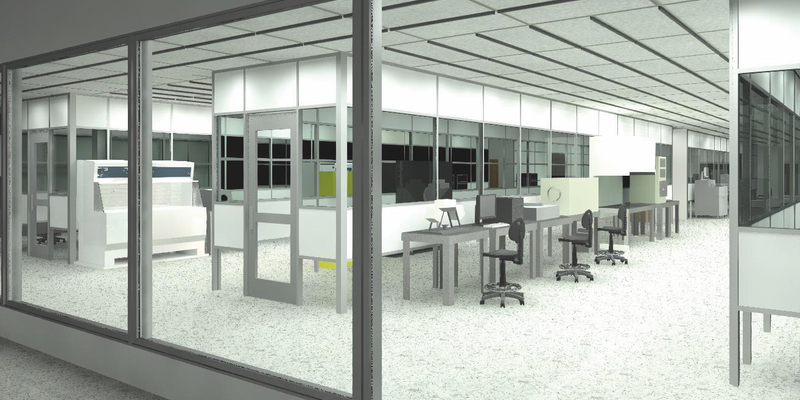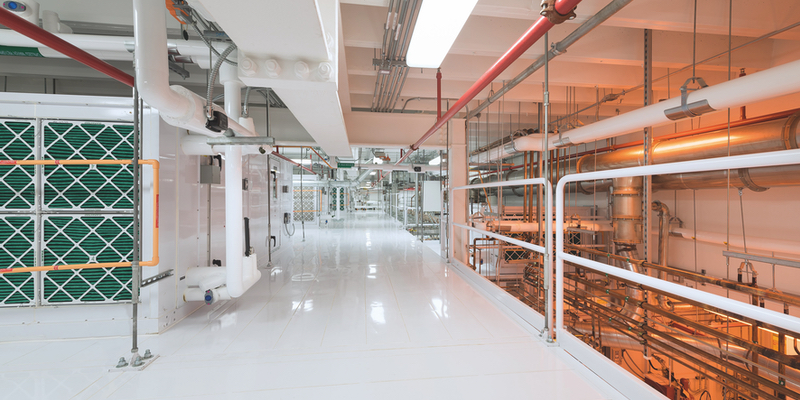Since the timing between the plan, build, and operation cycles may be long, challenges arise internally and externally over the time the facility is in operation. These are especially acute in the speciality of high technology facilities and cleanroom construction.
The foremost factor that any business faces is the fact that changes are inevitable. The initial design basis will undergo changes during development for many reasons, such as landscape shifts are faster, and compressed, innovations are accelerating, and competition increasing.
The need for agility is a necessity to successfully realise the project. Due to a significant increase in integration of technology across many industries, the competitive landscape requires that the manufacturing methods include elements that impact the competitiveness of the operations. This is in order to drive quality, cost and speed.
Some of the methods
Statistical process control that is automated and provides the "feed-forward" information to the next process step. This also includes automatic holds for any lots whose process outcomes are outside of statistical control limits.
Real-time control of processes, with "feed-forward" information to provide process parameter optimisations.
Fault detection control that monitors input parameters to provide a statistical control during processing of each step.
On lot information storage of key information including lot codes, process routing, current process step code.
Real-time yield optimisation that utilises data analytics combining previous lots' quality and performance, processing equipment quality performance, current lot quality data to determine whether the manufacturing line is running at required quality parameters and learning analytics to continuously and rapidly improve or sustain high quality.
Flexible manufacturing that will be able to respond to the changing market demand and be able to switch product lines as needed. This requires maximising the flexibility of the facility to be able to run multiple processes so that volume and cycle time flexibility is maintained.
Continuous manufacturing rather than batch manufacturing enables better flexiblility, better cycle time, and higher yields.
Predictive maintenance on top of corrective maintenance, which focuses on a goal of eliminating equipment performance and quality fails. This approach takes advantage of sensors, SPC and FDC along with data analytics and learning.
These factors force the business to carefully plan and successfully execute each of the Plan-Build-Operate phases.

Plan Cycle
Planning for a new cleanroom facility build will typically go through a long carefully measured process consisting of the following.
Firstly, the business plan & forecasting cycle that kicks off the project after approval. Next is Design - Bid - Build. These can be done either direct Design-Build, or a 3 step process of Design, to Bid, to Build. Once this has been done, the budget must be considered, looking at Plan vs. Design. Oftentimes, the budget that was initially set during the business plan is exceeded once the design bid is completed as the full budget cannot be accurately forecasted until the design is completed, and typically, additional scope features are added in with time and evaluations.
Value Engineering is next. If the forecasted cost is greater than the plan budget, an effort to reduce the cost, termed as "value engineering" is undertaken to reduce the cost. This may involve reducing scope elements while preserving the primary function. The greatest concern, one which does not often get properly understood is the negative impact on operational costs and flexibility in manufacturing. So total costs need to be considered, not just the build cost.
Build Cycle
Many changes will occur during the build cycle that may affect function, design, and budget. These factors have to be kept in mind when going through the initial design and particularly during value engineering. As much as possible, flexibility must be maintained as the initial design may not meet the competitive requirements at the time of completion.
Function vs. market changes: market demands may have changed from the initial products configured in the design.
Design vs. technology changes: similar to market changes, technology may have driven the competitive landscape to a different space than originally configured.
Functional changes: Particularly during the VE phase, which functional capabilities were affected, and how does that impact the ability to respond to Market and Technology changes?
Budget constraints: This will be an ongoing balancing effort throughout the entire process which may affect the factors described above. One particular concern will be the impact of changes on the operational costs as there may be a tradeoff between Capital Expense and Operational Expense.
These two phases (Plan and build) typically comprise 20% of the total cost. The highest cost over time by far is the Operational cycle.
Operational Cycle
With the build complete, operational ramp to full production begins.
During this phase, the impact of all the decisions taken throughout the design and build cycles is experienced. Primary among them is the functional performance of the facility. Functional performance vs. business plan is the primary factor that determines the viability of the facility. Do the total manufacturing capacity, product mix, throughput, costs, quality and cycle times match the business case? Is the facility competitive? So the questions must be asked again. How has the market demand changed, and how well can the facility meet those changes? What is the current competitive landscape, and can the site still meet its intended competitive position? What is the impact of technological changes to the facility?
Major impediments
The top impediments to cleanroom construction projects include; communications (how well organised, communicated, and aligned are the actual workers), planning methodology and risk management (how well are each task coordinated), and quality performance management (time to resolve issues).
But a primary problem seems to be the "Pick Two" out of cost-quality-schedule attitude that typically jeopardises scope for cost or schedule.
The impacts of these primary issues are easy to predict. Cost overruns are a typical first measurable impact. Then it hits a rework phase, where the team missed "First Time Right" execution. Then because of these, the schedule overruns and the project is forced to undergo recovery efforts. Recovery is attempted through two primary efforts; an increase in staffing that can lead to further cost overruns, or reducing the scope thereby impacting functionality, and possibly jeopardising the business plan parameters.
Most of all, the owner is further pressed to "Pick Two" out of cost, quality, and schedule, which further impacts future flexibility and business plan parameters. Since 80% of the cost occurs during the operational cycle, reducing scope negatively impacts operational costs.

Major constraints
There are four main ways to deal with these issues. A phased approach, contract alignment, planning, and communication.
A phased approach utilises a modular approach and construction technique for the project to provide efficiency and flexibility to:
- Enable future cleanroom capacity expansion - build in the ability to expand
- Enable technology adjustment - build in the ability to modify/upgrade
- Enable flexibility (multi-technologies, multi
This design for constructibility to enable phased/modular build addresses the current budget, by building what is needed now, but enables cost-effective expansion where future phases should not cost as equivalent independent facilities.
Pushing all of the risks onto the contractor results in higher costs
Contract Alignment is all about what are you incentivising? Understanding the unintended consequences of the contracting terms is a critically important analysis. Balancing the risks and sharing in the savings aligns the financial motivation which translates into performance. Aligning the interests of the owner and the contractors assures a positive partnership. Setting up an efficient process for payments, including change order and claims management is also important in assuring that the interests stay aligned and avoid negative cost impacts. Pushing all of the risks onto the contractor results in higher costs that are ultimately passed on to the owner.
And then there is the obvious, planning. There is sufficient expertise in project planning utilising software tools to provide control over all aspects of a major construction project, including managing documents, resources etc. However, there is still a miss in the close coordination of the short term - the period from the next day to next week time frames. A lot of this comes down not only to the planning, but equally to the communication strategy. The utilisation of lean construction has great benefits. But this begins with a practical approach in terms of project planning. As with the contracting strategy, aligning the objectives of each of the project & contractor groups is critical.
This is where that "Theory of Constraints" approach is highly valuable to assure that conflicts are not being unexpectedly set up during the planning process. Defining the core objective and aligning each of the sub-objectives directly to the core objective, with the right financial incentives in place. And throughout the project, assuring that all groups align to address the critical constraints.
Plan and build cycles typically comprise 20% of the total cost
The typical problems in execution have to do with behaviours like starting the task at the last moment, float time being seen as normal time thereby spreading completion of the task, or conducting the easy tasks rather than the important tasks.
Taking these into account, a better way is to conduct planning from the objective back to the starting point "pull planning" and determining the (longest) dependent tasks. Then aligning all groups on a (1) daily basis to deliver these dependent tasks, (2) looking ahead for the coming week, and (3) looking 6 weeks ahead to identify the constraints to delivering the dependencies and achieving the task objectives.
Finally, there are a lot of opportunities for gaps in communication that occur not only between groups (Inter-) but also within each group (Intra-). Even with the great efforts placed into planning the project, a large majority of the issues arise from communication gaps.
Intra-Communication and Alignment
A brief list of issues that occur within groups:
- Owner: Do all functions have alignment, especially as changes occur, and is the business plan being updated in real time?
- A&E: Internal communication between the business development team and the execution teams.
- Equipment Supplier: Internal communication between the business development team and the execution teams.
- Construction: Internal communication between the business development team and the execution teams
Between stakeholders lack of Alignment or Clarity - on a daily, weekly, monthly basis.
- RFI Process
- Change Management Process
Field Communications
Understanding and assuring first hand that there is appropriate coordination and communications in the field is critical for successful project execution.
Addressing this on a daily, weekly and monthly basis, and adapting the methods efficiently is necessary.
At the end of the day, you can successfully deliver on complex cleanroom construction projects utilising these learnings. One element that has not been discussed above is the culture of the company that is part of the project which is a critically important element for successful delivery. Culture that is based on the following fundamental principles will deliver success.
- Core Operating Principal: Doing what's right, and providing full accountability and transparency.
- Drive all three project deliverables of Cost, Quality and Speed. Don't operate on "pick two". Focus on 1st Time Right, enabling speed, cost effectiveness
- Focus on Communication in an effective and adaptive manner.
